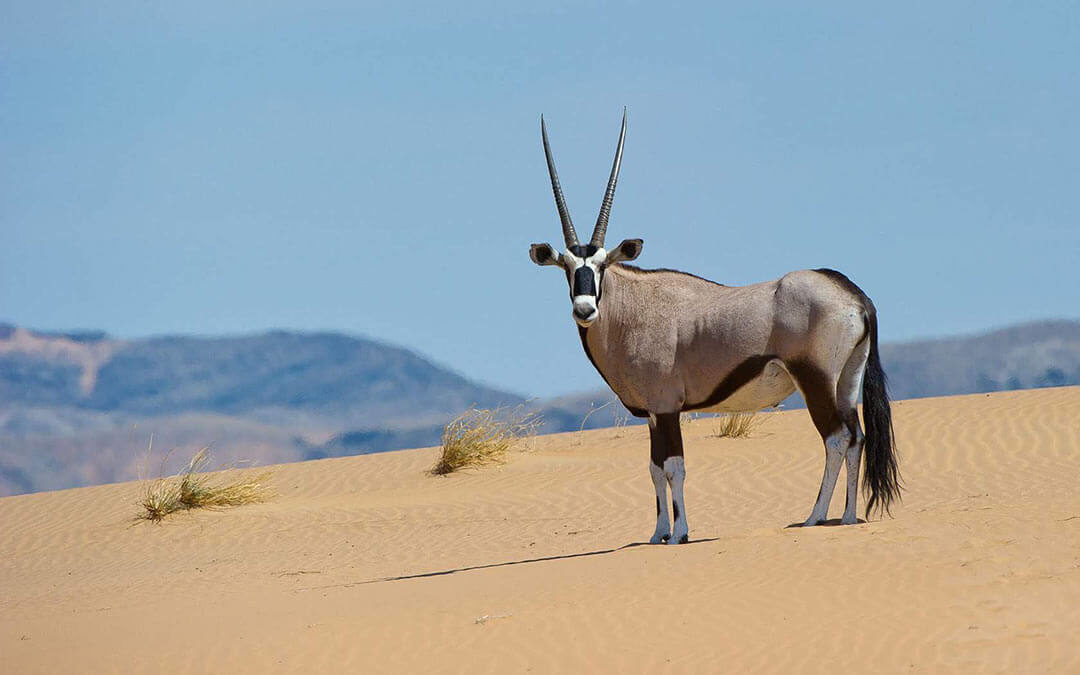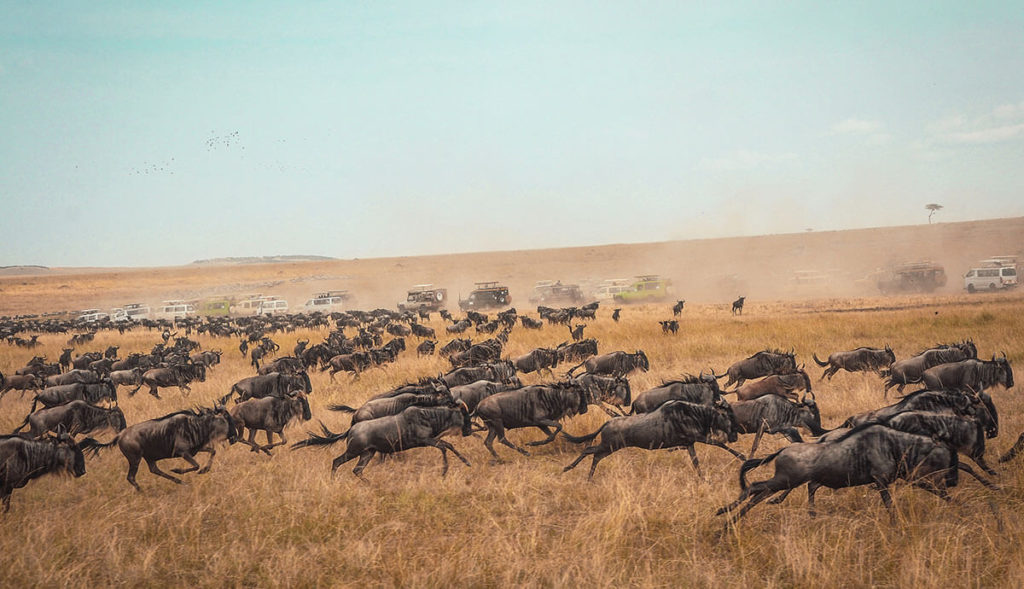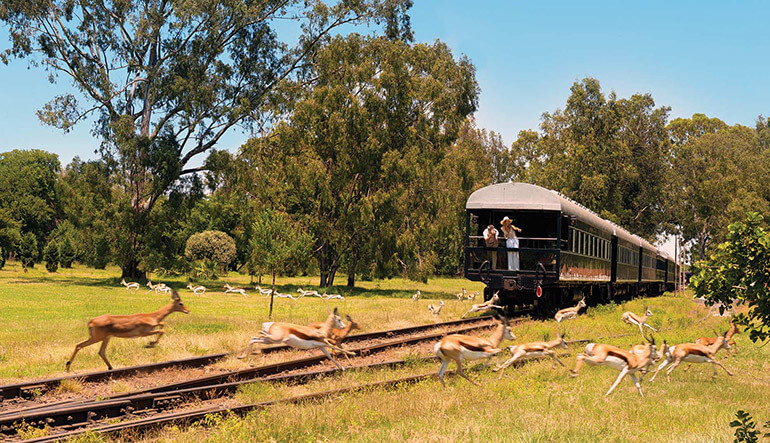There are so many different antelope species living across Southern Africa, and it is sometimes a challenge to recognise all of them!
We’ve rounded up a list of the most common antelope species to help you identify these beautiful animals during your next game drive. From distinctive features, habitat types and more, we ‘ve shared some of the most interesting facts about Africa’s antelope.
If you love animals as much as we do, check out our collection of animal facts.
What is an antelope?
It is rare to go on a game drive in Southern Africa and not see one of the most abundant fauna on the continent, the antelope.
Antelopes are a group of mammals that live in the vast plains of Africa. Each species of antelope varies in shape and size, but generally, all have a light figure with slender limbs, small cloven hooves and a short tail.
They are often distinguished by their horns, which may be straight, curved or twisted. In some species, only the male antelopes have horns.
Most antelope are social animals that live in groups called herds. The herds communicate with each other using a variety of sounds and scent signals. Sometimes, their scents can linger on for many days.
Antelope live in a wide range of habitats across Southern Africa including, open savanna, woodlands, marshes and even deserts. Most antelope species are herbivores that graze on grass or munch on buds, bulbs, fruits and leaves. They are intelligent animals that follow the rains to find fresh grass, as famously seen each year during the Great Migration.
Antelopes must always be on constant alert for danger as they are a target for predators such as cheetahs, lions, leopards and wild dogs. Their acute sense of hearing and sight, as well as their powerful horns, help to protect them in the face of predators.
What is the difference between antelope and deer?
They might appear similar, but antelopes and deers have distinct differences, the most significant of which is their scientific classification. Antelope belong to the Bovidae family (along with goats, sheep and buffalos), while deer belong to the Cervidae family (as do elks and moose).
The most notable difference between antelope and deer is their physical appearances and physical abilities. Male deers have antlers that appear to branch outward which are shed annually, while antelopes have permanent horns. Their horns are made from a hard material called keratin, which is also found in fingernails.
Where can I see Antelopes in South Africa
Take a safari tour in South Africa and you’re bound to see an antelope. This can be a mere one-day excursion or you can take your time, enjoying nature for a couple of days.
- Full-Day Big Five Safari Tour
- 5-Day Garden Route Safari
- Aquila Game Reserve Tour
- 2-Day Safari from Cape Town
Species of Antelope found in Southern Africa
Wildebeest
Wildebeest are famous for making their annual migration across the African plains. Each year, thousands of wildebeest, and other antelope species, trek from the Serengeti to the Masai Mara in search of fresh grazing grounds. This natural phenomenon is known as the Great Migration. During the Great Migration, a large number of wildebeest will drown while crossing the Mara River or are killed by predators lurking close by.
There are two species of wildebeest in Southern African: the black and blue wildebeest.
- The blue wildebeest species explore a variety of habitats, migrating over various places. They live in open grasslands, woodlands and desert areas.
- The black wildebeest prefer to live in open grasslands and only migrate over short distances.
Read more interesting facts about wildebeest.
Eland
Elands are the largest species of antelope in the world. A full-grown adult eland can weigh up to 900kg, almost as much as the Cape Buffalo. There are two subspecies: the common eland, and the greater eland.
These cow-like animals are distinguished by their large shoulder hump and tightly spiralled horns. Although they are the largest and slowest of the antelope species, elands are fantastic jumpers, able to jump a 1.5-meter fence from a standstill.
Elands are found in savanna plains, semi-desert regions and mixed woodlands areas. They are one of the most gentle wild animals and will not charge even if cornered. Unfortunately, they have become one of the most endangered species of antelope due to illegal poaching and habitat loss.
Sable
Sable is another large species of antelope. Bearing a distinctive black body with white markings, and elongated horns, these striking creatures are a treat to see during a game drive. Sable antelopes live in mixed savanna woodlands, most visible in Pretoriuskop, Southern Kenya and South Africa
There is a strict hierarchy in their social structure with a dominant male leading the herd. Sables are aggressive when it comes to predators and the males exhibit warning signals by using their horns. Sable antelopes are known to charge opponents such as lions, wild dogs and cheetahs. Predators are reluctant to challenge these brave fighters.
Waterbuck
Robust and well-built, the most distinctive feature of the waterbuck is the white ring around their backsides. Safari guides joke that it looks as if they’ve sat on a freshly painted toilet seat. These massive animals can weigh up to 250 kg and reach a shoulder height of around 120 to 136 cm. Only the males have horns, which curve upwards.
Waterbuck are strong runners and often use water holes as a refuge when trying to escape predators. The waterbuck lives in areas that are close to water, such as savanna grasslands, forests and riverine woodlands. The colour of their shaggy coat may be an indicator of their age, as it darkens as they mature.
Springbok
Mostly found in South Africa, springbok are recognised by their striking body colour and small frame. They have light brown upper coats, white underparts and a dark brown stripe across their bodies.
Springboks are well-known for their leaping prowess. They can easily leap 4 meters into the air by bouncing with a rounded back and all four feet off the ground. The springbok is South Africa’s national animal as well as the symbol of our national rugby team.
Springboks are selective eaters that have a preference for young leaves, flowers and fresh grass. They prefer grazing after the rainy season when the grass is fresh and green.
Steenbok
One of the smaller antelope species in Southern Africa is the steenbok. These tiny mammals have a reddish-brown coat with white underparts and a y-shaped marking on their nose.
Unlike other antelope species, which stay together in groups, steenboks are mainly solitary browsers, which can sometimes be found in monogamous pairs. They live in the open savanna where they can find adequate cover in the form of tall grass and bushes.
Due to their selective eating habits, steenboks can survive without a freshwater source. When water is scarce, these animals meet their water requirements by eating moisture-rich plants and roots.
Common duiker
Duikers are slender animals with an arched back and glossy coat. They get their name from the Afrikaans word ‘duiker’ which means to dive.
Duikers are timid animals and have a habit of diving into bushes when they sense danger. These small antelopes are mostly active at night when they feed on grass, leaves and fruit, but are also known to eat small insects and even nestling birds.
Widely distributed throughout Southern Africa, duikers can be found in woodlands, desert regions and grasslands. Duikers are tiny animals with only the males having short horns. The adult males have a mass between 15-18 kg, while the females are between 16-21 kg.
Reedbuck
The reedbuck is a small, slender and shy antelope with a predominantly grey coat and a fluffy white tail. Reedbucks tend to rest in the grass beds during the day and graze during sunrise and sunset, or sometimes at night.
This species of antelope needs a sufficient supply of water to survive. They often occupy areas that are close to water sources. They usually live alone or in pairs, but can sometimes be seen in small herds of three to 10 animals. Reedbucks inhabit moist woodlands and tall grasslands with sufficient cover and water nearby.
Oryx
The oryx, also known as the gemsbok, is a large species of cow-like antelope with incredible endurance and strength. The oryx is at home in the vast shadeless desert or landscapes with near-desert conditions.
Their bodies have adapted to survive against the harsh African sun, and can survive without water for long periods. Even though they are deprived of drinking water in the desert, oryx feed on succulents, nutritious leaves and roots.
Both sexes of this species have been known to kill attacking predators by piercing them with their powerful horns.
Impala
Impalas are very athletic animals who are known for their leaping abilities. They can execute jumps of two meters high and can cover a distance of 10 meters. They have slender bodies and large horns that curve forwards.
Impalas are both grazers and browsers that feed on grass herbs, leaves, shoots and bulbs. Their natural habitat is in the woodlands and low grassland areas often near a source of water. During the dry season, impalas will gather in groups of hundreds to search for food. During this time, young impala get together in groups called creches, where they love to play and groom each other.
Kudu
Kudus are large antelope that can stand at 1.5 meters at the shoulder and weigh over 200 kg. Despite their size, kudus are slender and built to jump over high obstacles. Kudus can be recognised quickly thanks to their unique horns that twist upwards.
Kudus live in small herds which mainly consist of the females and their calves. When they flee from danger, their raised tails flash a white signal for the rest of the herd to follow. Kudus are known to use their horns as a defence when under attack.
Their preferred habitat includes thick woodlands, riverine forest areas, bush on lowlands, mountains and hills.
Bushbuck
Bushbuck are medium-sized antelope with a feisty temper and unusual coat. They have a deep chestnut brown coat with a few white spots and a crest of white hair running along their backs. They are solitary browsers that can usually be spotted between dense bushes or thorn thickets.
Unlike most antelope species who live on savanna plains and open grasslands, bushbucks are forest-dwelling. Bushbucks in different areas have versatile coat colours and eating habits. As a herbivore, their diet consists mainly of shrubs, buds, herbs, flowers and fruit.
Antelopes are graceful animals that live in a variety of regions throughout Southern Africa. On a safari game drive, you will likely encounter hundreds of antelopes during one single outings. Sometimes, you can even spot them in open grasslands in the city or on the side of the road close to the countryside.
They are cautious by nature and quick to retreat, so a surprise sighting of these animals is truly special. With this guide you can learn how to recognise different antelope species by the colour of their coats or the size of their horns.
We hope that you enjoyed learning about the variety of antelope species in Southern Africa. What is your favourite antelope species? Let us know in the comment section below.




Thank you for putting all the different antelope species, There are so many kinds of antelopes and all of them are amazing.
For sure!
The hartebeest, also known as kongoni or kaama isn’t in this list
What is species on Texas ranch near Tapatio resort ( Beorne) horns are long, straight, and nearly parallel